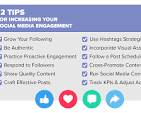Unlocking the Potential: How Social Media Enhances Engagement Strategies
The Power of Social Media in Increasing Engagement
Social media has revolutionised the way businesses interact with their audience. With the rise of platforms such as Facebook, Instagram, Twitter, and LinkedIn, companies now have unprecedented opportunities to engage with their customers in real-time.
One of the key benefits of social media is its ability to increase engagement. By creating compelling content and actively interacting with followers, businesses can build a loyal community that is eager to interact with their brand.
Here are some ways social media can help increase engagement:
- Content Sharing: Sharing relevant and interesting content on social media can attract likes, shares, and comments from followers. This not only increases engagement but also helps in spreading brand awareness.
- Interactive Features: Many social media platforms offer interactive features such as polls, quizzes, and live videos. These tools encourage followers to actively participate and engage with the brand.
- Customer Feedback: Social media provides a direct channel for customers to provide feedback and ask questions. By responding promptly and effectively, businesses can show that they value customer input and are committed to providing excellent service.
- Influencer Collaborations: Partnering with influencers or industry experts on social media can help reach a wider audience and boost engagement. Influencers can create authentic content that resonates with their followers and drives interaction.
In conclusion, social media is a powerful tool for increasing engagement with your audience. By leveraging the various features and strategies available on different platforms, businesses can foster meaningful connections with their customers and drive loyalty towards their brand.
8 Effective Tips to Boost Social Media Engagement
- Post consistently to stay visible to your audience.
- Use high-quality visuals to grab attention.
- Engage with your followers by responding to comments and messages promptly.
- Run contests or giveaways to encourage interaction.
- Collaborate with influencers or other brands for wider reach.
- Share user-generated content to build a sense of community.
- Utilise hashtags strategically to expand your reach.
- Analyse your data regularly to understand what content resonates best with your audience.
Post consistently to stay visible to your audience.
Posting consistently on social media is crucial to maintaining visibility and engagement with your audience. By regularly sharing content that is relevant and valuable, you can keep your followers interested and connected to your brand. Consistency helps establish a routine for your audience, making them more likely to anticipate and engage with your posts. This practice not only strengthens your online presence but also reinforces brand loyalty and trust among your followers. Remember, staying visible through consistent posting is key to building a strong and engaged community on social media.
Use high-quality visuals to grab attention.
Utilising high-quality visuals is a crucial tip for increasing engagement on social media platforms. Eye-catching images and videos have the power to captivate the audience’s attention and convey messages more effectively than text alone. By incorporating visually appealing content into social media posts, businesses can stand out in crowded feeds, encourage users to stop scrolling, and ultimately drive higher levels of engagement. Investing in professional photography, graphic design, and video production can significantly enhance the visual appeal of social media posts, making them more shareable and memorable for the audience.
Engage with your followers by responding to comments and messages promptly.
To increase engagement on social media, it is crucial to actively engage with your followers by responding to comments and messages promptly. By acknowledging their feedback and queries in a timely manner, you show that you value their input and are committed to building a meaningful relationship. Prompt responses not only encourage further interaction but also help in creating a positive impression of your brand, fostering trust and loyalty among your audience.
Run contests or giveaways to encourage interaction.
Running contests or giveaways on social media is a highly effective strategy to boost engagement with your audience. By offering exciting prizes and incentives, businesses can encourage followers to interact with their content, share their posts, and participate actively in the contest. Contests create a sense of excitement and anticipation among followers, driving up engagement levels and increasing brand visibility. This interactive approach not only fosters a stronger connection with your audience but also helps attract new followers who are drawn to the engaging and rewarding experience offered by the contest or giveaway.
Collaborate with influencers or other brands for wider reach.
Collaborating with influencers or other brands is a highly effective strategy to expand your reach and increase engagement on social media. By partnering with influencers who have a strong following and credibility in your industry, you can tap into their audience and leverage their influence to promote your brand. This collaboration not only helps you reach a wider demographic but also adds authenticity to your brand message, driving higher levels of engagement and interaction with your target audience.
Share user-generated content to build a sense of community.
Sharing user-generated content is a valuable strategy to enhance engagement on social media platforms. By showcasing content created by your audience, you not only acknowledge and appreciate their contributions but also foster a sense of community among your followers. User-generated content adds authenticity to your brand and encourages others to participate, creating a dynamic and interactive online community. This approach not only boosts engagement but also strengthens the bond between your brand and its audience, leading to increased loyalty and advocacy.
Utilise hashtags strategically to expand your reach.
Utilising hashtags strategically is a valuable tip to increase engagement on social media. By incorporating relevant and popular hashtags into your posts, you can expand your reach and connect with a wider audience who are interested in the topics you are discussing. Hashtags help categorise content, making it easier for users to discover and engage with your posts. When used effectively, hashtags can boost visibility, attract new followers, and encourage interactions such as likes, comments, and shares. Remember to research trending hashtags in your industry and use them thoughtfully to maximise the impact of your social media efforts.
Analyse your data regularly to understand what content resonates best with your audience.
Regularly analysing your data is crucial for understanding what content resonates best with your audience on social media. By reviewing metrics such as engagement rates, click-through rates, and demographics, you can gain valuable insights into the type of content that captures the interest of your followers. This data-driven approach allows you to refine your content strategy, tailor your messaging to better meet the needs of your audience, and ultimately increase engagement levels across your social media platforms.




